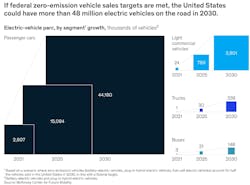Powering EVs with Real-Time Insights: How Technology Fosters Consumer Confidence by Reducing Charging Wait Times
Electric vehicle (EV) adoption is only increasing. A growingly sustainable-conscious consumer base has spurred demand for EVs across the U.S., propelling more and more EVs through production lines. But is crunch time coming?
To what extent can EV adoption continue before infrastructure challenges become a critical pain point?
Well, the issue is already upon us – EV charging queue chaos and “range anxiety” are headaches felt extensively by today’s consumers. It’s time the IT behind EV charging points was put up for reconsideration, as Event Driven Architecture presents new opportunities for consumers and how they interact with EV charging points to check status and availability.
The Current State of EV Charging Points
According to Kelly Blue Book, almost 6% of all cars sold in the U.S. in 2022 were electric. While this might seem a small percentage, total units equated to 800,000 vehicles. Add to this the constant annual increase in electric vehicle purchases and it’s clear that usage will have a ripple effect on the infrastructure required to support this load.
Charging is a pain point that consumers are beginning to feel. Recent estimates show there are currently more than 148,000 EV charging points across 56,000 stations in the U.S.
But, according to the American Petroleum Institute, there are more than 145,000 conventional fueling stations, and with each station averaging between 6 and 12 pumps, the total number of gas pumps ranges between 900,000 and 1.8 million.
EV charging points have some distance to make up.
The government is aware of the challenge – the White House wants to nearly triple the number of EV charging points by building a national network of 500,000 EV chargers, and the 2021 Bipartisan Infrastructure Law includes $7.5 billion to fund its construction.
Inadequate Charging Infrastructure Leaves Consumers “Powerless"
With demand outpacing supply, many drivers are arriving at charging stations and being met with a full car park or a number of broken chargers. McKinsey found that nearly half of U.S. consumers say that battery or charging issues are their top concerns surrounding buying EVs.
It’s no stretch to say that the nation’s limited network of charging stations is beginning to discourage many prospective buyers.
In fact, the Associated Press-NORC Center for Public Affairs Research and the Energy Policy Institute at the University of Chicago found high prices and too few charging stations the main deterrents to EV purchasing – concluding that only around 4 in 10 U.S. adults are at least somewhat likely to switch.
If not addressed, this has the potential to undermine all the hard work completed so far to create a greener planet.
Keep Consumers Informed and Reduce Chaos with EV Charging Apps
Another issue deterring people from the EV option is the lack of reliable information coming from EV charging apps. These apps identify where the next charging points are and whether they are available.
The problems occur because the apps aren’t always able to provide updates quickly enough to the driver, inevitably causing incorrect or outdated messages to be communicated to them.
For example, the app will report that a charger is available, but when the driver arrives, they find it is either in use or broken. More often than not, the result of this leads to a build-up of vehicles queuing for access to the charging station.
In comparison to a traditional service station, which is designed to form queues and rapidly dispense fuel, EV users are left without knowing where they are in that queue, who got there first, and how long they’ll need to wait before a charger is made available to them.
This uncertainty can lead to unnecessary wait times and longer journeys.
Waiting drivers are also forced to wait in lanes where traffic should be flowing, causing vehicles to act as obstructions, blocking the view of the charging points and causing inescapable chaos.
It is also possible that drivers will have to continue driving to the next station without any reassurance that it will have a working charging point available for them.
Success Lies in Real-Time Data – A Critical Infrastructure Component
What is vital to the success of EVs is the ability to access charging point status information as soon as possible, with live updating of charging point availability. Thankfully, technological capabilities do exist for this today.
Real-time data movement is critical in resolving these pitfalls crippling the system – EV manufacturers need to understand that the success of broad EV usage is hinged on such an infrastructure.
“Range anxiety,” the worry of how many miles an EV can go before recharging, has now become “charge anxiety,” the worry that drivers won’t be able to complete their full journeys due to a lack of chargers.
For drivers to have trust in EVs as a long-term investment, they must have reliable location information, updated instantly, to plan their next charge.
How Event Driven Architecture Can Make It All Possible
The movement of real-time data can be enabled through an Event-Driven Architecture (EDA). Defined as a software design pattern, EDA is an enterprise IT system that allows the natural flow of applications, microservices, and connected devices in a real-time manner as events occur throughout a process.
An “event” and “event streaming” are ways of thinking about real-time data movement. A virtual queuing system can be created using EDA to gather real-time location information on where the cars are, the status of the charging points, and who has arrived and is leaving.
By using real-time instrumentation to gather the status of cars, charging points, and back-end systems, the EV charging process can be successfully orchestrated. This technology could allow an EV to be automatically registered in a virtual queue based upon identifying when you arrive at the charging point and then estimating the necessary wait time. It allows drivers the opportunity to park out of the way of traffic and be notified once their charging station is available.
By implementing as-it-happens information on available charging points, governments, and EV manufacturers can put the decision-making and trust back into the hands of drivers. This will not only aid in increasing demand for EVs long-term but also ensure the driving experience for all involved is better streamlined.
This will create a more efficient service when charging on the go.
The result? A more enjoyable journey, without any EV anxiety, paving the way for increased consumer confidence and optimized use of a growing charging network.
It’s the boost EVs will need to accelerate consumer adoption.
About the Author
Steve Buchko was one of Solace’s earliest employees. Currently a VP of Product Management, Steve has architected Solace products and developed customer solution architectures. Before Solace, Steve built networking products at Alcatel Canada and Newbridge Networks. As an EV owner for almost 5 years, he’s made many road trips in his EV.


